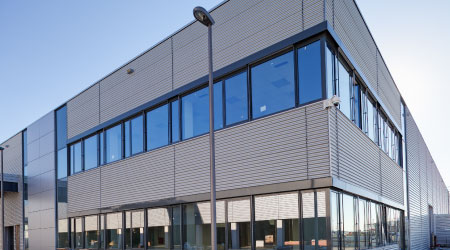Understanding Metal Reroofing Projects
Part 2 of a 2-part article on the potential advantages and challenges of metal systems
As is true with metal wall systems installed on an existing building, a metal reroofing project offers an opportunity to make a dramatic impact on the appearance of a building. Low-sloped roofs on buildings where the facility manager wants to "change the aesthetic or relocate the HVAC units" can be transformed by constructing a steep-sloped area with framing to conceal HVAC in the roofing system, notes Robert Moore, principal, Metal Roof and Building Consultants. Such systems include louvres for ventilation.
Another important consideration is that unforeseen conditions can pop up. "If a design team does not have enough time to fully validate existing conditions, they may get a surprise," says Eric Sassak, building enclosure specialist and member of the building technology studio at SmithGroup JJR.
"Owners have to be honest with themselves. Unless sufficient time and effort is spent investigating the existing building conditions, additional contingency funds need to be allocated to take care of those surprises," Dunlap says.
Sometimes an installation involves prefabricated material, says Deborah Costantini, senior architect, Hoffmann Architects. The purchase of a manufacturer’s product can involve picking stock material that is then customized. "In picking stock material you have to watch out for the detailing at the edges, whether it’s a drip edge (gutter line), ridge, or penetration (vent pipes, skylights, and anything else that sticks through the roof surface)," Costantini says. "The designer has to make sure the detailing is appropriate." Some manufacturers have custom pieces to go with a roof system, or the contractor may have to fabricate them, but "it’s nice to have a system," says Costantini, "because if there is a problem, one person is responsible for it, so you can warranty everything as whole."
Metal Is a Long-Term Solution
It’s also important for facility managers to ensure that decisions based on cost aren’t shortsighted. "A lot of times roofing material companies have a strong sales force and may try to influence a situation," says Sassak. On such an occasion the team can go back to the targets and address whether the material will meet the initial goals. Sometimes there is a budgetary issue, and the team understands that the project has to scale back, he says.
There is also a danger of the facility manager getting "caught up in price savings in the guise of ‘value engineering,’ " says Moore. "This is the biggest downfall of the public market; half the time the public is getting less than what it needs."
A metal roof or wall system represents a considerable long-term investment in the facility, and facility managers are ultimately responsible for the success of the project. As buyers they need to be cautious, well-informed, and above all, attentive.
Maryellen Lo Bosco is a freelance writer who covers facility management and technology topics. She is a contributing editor for Building Operating Management.
Related Topics:














